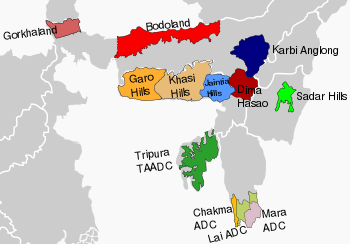Article 244 A of the Constitution
Context
-
Recently, it has been promised to implement Article 244 A of the Constitution to safeguard the interests of the people in Assam’s tribal-majority districts.
What is Article 244 A of the Constitution?
- Article 244(A) allows for creation of an ‘autonomous state’ within Assam in certain tribal areas.
- Inserted into the Constitution in 1969 by the then Congress government, it also has a provision for a Legislature and a Council of Ministers.
How is it different from the Sixth Schedule of the Constitution?
- The Sixth Schedule of the Constitution — Articles 244(2) and 275(1) — is a special provision that allows for greater political autonomy and decentralised governance in certain tribal areas of the Northeast through autonomous councils that are administered by elected representatives.
- In Assam, the hill districts of Dima Hasao, Karbi Anglong and West Karbi and the Bodo Territorial Region are under this provision.
- Article 244(A) accounts for more autonomous powers to tribal areas. According to Uttam Bathari, who teaches history at Gauhati University, among these the most important power is the control over law and order. “In Autonomous Councils under the Sixth Schedule, they do not have jurisdiction of law and order.
How did the demand arise?
- In the 1950s, a demand for a separate hill state arose around certain sections of the tribal population of undivided Assam. In 1960, various political parties of the hill areas merged to form the All Party Hill Leaders Conference, demanding a separate state. After prolonged agitations, Meghalaya gained statehood in 1972.
- “The leaders of the Karbi Anglong and North Cachar Hills were also part of this movement,” said Bathari. “They were given the option to stay in Assam or join Meghalaya.”
- Since then, there has been a demand for its implementation.
- In the 1980s, this demand took the form of a movement with a number of Karbi groups resorting to violence. It soon became an armed separatist insurgency demanding full statehood.
- While in February 2021, 1,040 militants of five militant groups of Karbi Anglong district ceremonially laid down arms at an event in Guwahati in the presence of Chief Minister, the entire political discourse here still revolves around the demand for grant of ‘autonomous state’ status to the region.
Autonomous administrative divisions
- The Sixth Schedule of the Constitution of India allows for the formation of autonomous administrative divisions which have been given autonomy within their respective states.
- Most of these autonomous district councils are located in North East India but two are in Ladakh, a region administered by India as a union territory.
- Presently, 10 Autonomous Councils in Assam, Meghalaya, Mizoram and Tripura are formed by virtue of the Sixth Schedule.
- Executive and legislative powers
-
- Land management
- Forest management
- Water resources
- Agriculture and cultivation
- Formation of village councils
- Public health
- Sanitation
- Village and town level policing
- Appointment of traditional chiefs and headmen
- Inheritance of property
- Marriage and divorce
- Social customs
- Money lending and trading
- Mining and minerals
- Judicial Powers
- Powers to form courts to hear cases where both parties are members of Scheduled Tribesand the maximum sentence is less than 5 years in prison.
- Taxation and Revenue
- Powers to levy taxes, fees and tolls on; building and land, animals, vehicles, boats, entry of goods into the area, roads, ferries, bridges, employment and income and general taxes for the maintenance of schools and roads.
For Other Indian Polity and Constitution Current Affairs : Click Here



